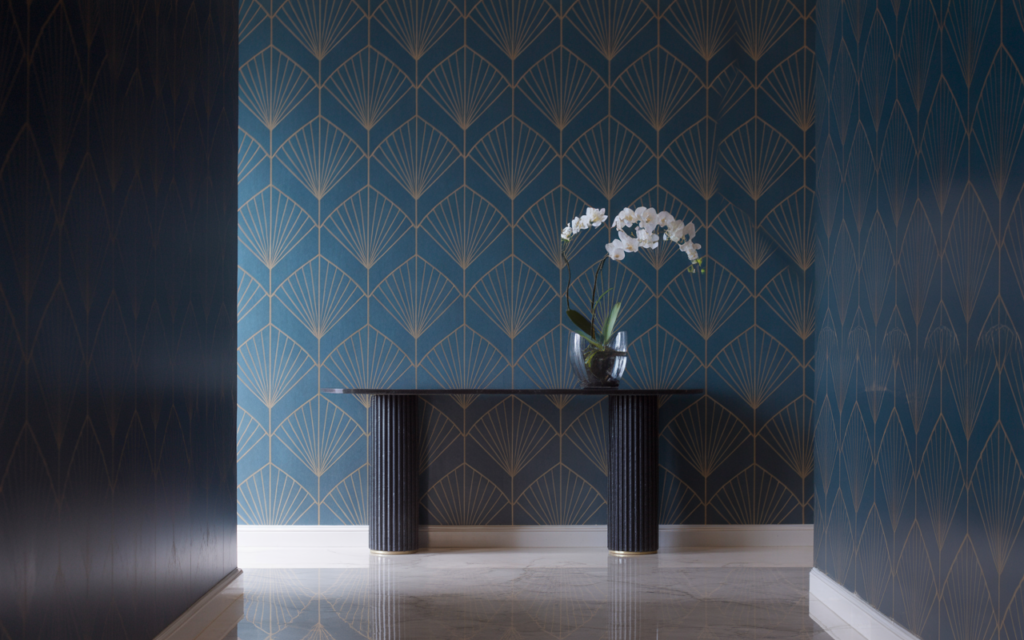
Paint has long been the default choice for interiors, but to truly elevate a space with personality, texture, and artful design, nothing compares to a high-quality wallcovering. Whether you envision a subtle, textured backdrop or a bold, dramatic feature wall, the world of decorative wall treatments offers limitless possibilities that paint simply cannot replicate.
This comprehensive guide will walk you through everything you need to know—from the vast array of types and materials available to the latest trends shaping modern interiors. Consider this your essential resource for transforming any room from ordinary to extraordinary.
A wallcovering is any material applied to an interior wall for decorative or functional purposes. While often used interchangeably with “wallpaper,” the term encompasses a much broader category of materials, including luxurious fabrics, natural grasses, metallic foils, and durable vinyls. The history of decorating walls dates back centuries, evolving from early tapestries and painted leathers into the modern materials we use today, a history well-documented by sources like Wikipedia. Unlike paint, which provides a flat layer of color, this type of finish introduces pattern introduces pattern, depth, and tactile qualities that can completely redefine a room’s atmosphere.
Opting for a decorative wall finish over paint or other finishes offers several distinct advantages that appeal to both designers and homeowners.
This comprehensive guide will walk you through everything you need to know—from the vast array of types and materials available to the latest trends shaping modern interiors. Consider this your essential resource for transforming any room from ordinary to extraordinary.

Navigating the world of wallcoverings begins with understanding the primary materials. Each type has unique characteristics, benefits, and ideal use cases.
Wallpaper is the most common type of wallcovering, defined by its paper-based construction, and it comes in several popular forms.
This is the most durable option available. It consists of a paper or fiber base with a printed vinyl top layer, making it washable, scrubbable, and resistant to moisture. It is an excellent choice for high-traffic areas like hallways, kitchens, and bathrooms.
Made from a blend of synthetic and natural fibers, non-woven wallpapers are celebrated for their ease of installation and removal. They are breathable, which helps prevent mold and mildew, and they don’t expand or contract when wet. They can be peeled off in full sheets without damaging the wall, making them a renter-friendly option.
For a truly luxurious and sophisticated finish, textile wallcoverings bring unparalleled texture and richness to a room.
Woven from natural fibers like seagrass, jute, and sisal, grasscloth is a high-end option prized for its organic texture and subtle color variations. Each panel is unique, creating a beautifully paneled effect on the wall. Due to its delicate nature, it is best suited for low-traffic areas like dining rooms and studies. Explore our complete guide to Grasscloth Wallcovering.
These fabrics offer a soft, elegant sheen and a refined finish. They are perfect for creating a formal, upscale look in master bedrooms or formal living rooms but require professional installation and care.
With so many options, selecting the perfect wallcovering can feel overwhelming. Focus on these three key factors to narrow down your choices.
The room’s purpose dictates the material’s requirements. For bathrooms and kitchens, prioritize moisture-resistant materials like vinyl. For living rooms and bedrooms, you can explore more delicate options like grasscloth or non-woven papers.
Ensure the wallcovering complements your existing decor. A bold, geometric pattern may suit a mid-century modern home, while a subtle damask or floral print works beautifully in a traditional space.
A general rule is that large-scale patterns work best in larger rooms, as they can overwhelm smaller spaces. Small, intricate patterns (ditsy prints) can add a touch of charm to smaller rooms or powder rooms without feeling too busy.
The world of interior design is always evolving. Staying aware of current trends can help you make a choice that feels fresh and modern. The key directions for 2025 include bold botanicals, a revival of geometric patterns, and a strong focus on sustainable, textural surfaces. Discover the top wallcovering trends for 2025 in our detailed report.
While some modern wallpapers are designed for DIY application, achieving a seamless, professional finish with high-end materials often requires an expert. Professional installers can handle complex patterns and delicate fabrics, ensuring your investment looks its best. For more details, you can read our practical guide to wallpaper installation.
A wallcovering is more than just a decoration; it’s a foundational element of interior design that sets the tone for your entire space. By understanding the different types, materials, and styles available, you can move beyond the limitations of paint and choose a wallcovering that truly reflects your vision.
Ready to explore the possibilities? Browse our curated collection of designer wallcoverings today.